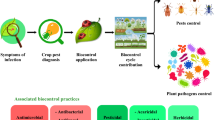Abstract
We have isolated and characterized six chemically induced mutants of the filamentous fungusAspergillus nidulans that are resistant to the experimental fungicide 8-chloro-4-(2-chloro-4-fluoro-phenoxy)quinoline (LY214352). The mutants are 13- to 430-fold more resistant to LY214352 than the parental strain, and one of the mutant strains requires LY214352 for maximal growth. The resistance trait is governed by a single dominant or partially dominant gene in each mutant, and it is likely that all of the mutations are allelic. The LY214352-resistant mutants were not cross-resistant to other compounds that inhibit the growth ofA. nidulans. The implications of these findings on the potential for development of resistance to LY214352 are discussed.
Similar content being viewed by others
Literature Cited
Borck K, Braymer HD (1974) The genetic analysis of resistance to benomyl inNeurospora crassa. J Gen Microbiol 85:51–56
Coghlan MJ, Krumkalns EV, Caley BA, Hall HR, Arnold WA (1991) Synthesis and investigation of 4-phenoxyquino-lines as novel agents for the control of cereal and grape powdery mildew. In: Moberg WK (ed) The synthesis and chemistry of agrochemicals II. Washington, D.C.: ACS, pp 538–552
Davidse LC (1981) Resistance to acylalanine fungicides inPhytophthora megasperma f. sp.medicaginis. Neth J Plant Pathol 87:11–24
Davidse LC (1986) Benzimidazole fungicides: mechanism of action and biological impact. Annu Rev Phytopathol 24:43–65
Davidse LC, Hofman AE, Velthius GCM (1983) Specific interference of metalaxyl with endogenous RNA polymerase activity in isolated nuclei fromPhytophthora megasperma f. sp.medicaginis. Exp Mycol 7:344–361
Dekker J (1987) Development of resistance to modern fungicides and strategies for its avoidance. In: Lyr H (ed) Modern selective fungicides. New York: John Wiley and Sons, pp 39–52
De Waard MA, van Nistelrooy JGM (1980) An energy-dependent efflux mechanism for fenarimol in a wild-type strain and fenarimol-resistant mutants ofAspergillus nidulans. Pesticide Biochem Physiol 13:255–266
Dovas C, Skylakakis G, Georgopoulos SG (1976) The adaptability of the benomyl-resistant population ofCercospora beticola in Northern Greece. Phytopathology 66:1452–1456
Edlich W, Lyr H (1987) Mechanism of action of dicarboximide fungicides. In: Lyr H (ed) Modern selective fungicides. New York: John Wiley and Sons, pp 107–118
Elbein AD (1981) The tunicamycins—useful tools for studieson glycoproteins. Trends Biochem Sci 6:219–221
Georgopoulos SG, Chrysayi M, White GA (1975) Carboxin resistance in the haploid, the heterozygous diploid, and the plant-parasitic dicaryotic phase ofUstilago maydis. Pesticide Biochem Physiol 5:543–551
Henry MJ, Trivellas AE (1989) Laboratory-induced fungicide resistance to benzimidazole and azole fungicides inCercospora beticola. Pesticide Biochem Physiol 35:89–96
Hori M, Kakiki K, Misato T (1974) Interaction between polyoxin and the active center of chitin synthetase. Agr Biol Chem 38:699–705
Katan K, Shabi E, Gilpatrick JD (1983) Genetics of resistance to benomyl inVenturia inaequalis isolates from Israel and New York. Phytopathology 73:600–603
Kerridge D, Whelan WL (1984) The polyene macrolide antibiotics and 5-fluorocytosine: molecular actions and interactions. In: Trinci APJ, Ryley JF (eds) Mode of action of antifungal agents. New York: Cambridge University Press, pp 343–376
Kodama O, Akatsuka T (1982) Kitazin P and edifenphos, possible inhibitors of phosphatidylcholine biosynthesis. In: Muatsunaka S, Hutson DH, Murphy D (eds) Pesticide chemistry: human welfare and the environment, vol. 3. New York: Pergamon Press, pp 135–140
Leroux P, Fritz R (1984) Antifungal activity of dicarboximides and aromatic hydrocarbons and resistance to these fungicides. In: Trinci APJ, Ryley JF (eds) Mode of action of antifungal agents. New York: Cambridge University Press, pp 207–237
Lyr H (1987) Mechanism of action of aromatic hydrocarbon fungicides. In: Lyr H (ed) Modern selective fungicides. New York: John Wiley and Sons, pp 75–89
Misato T, Kakkiki K, Hori, M (1977) Mechanism of polyoxin resistance. Neth J Plant Pathol 83 (S1):253–260
Pontecorvo G, Rope JA, Hemmons LM, MacDonald KD, Bufton AWJ (1953) The genetics ofAspergillus nidulans. Adv Genet 5:141–238
Ryley JF, Wilson RG, Gravestock MB, Poyser JP (1981) Experimental approaches to antifungal chemotherapy. In: Garattini S, Goldin A, Hawking F, Kopin IJ (eds) Advances in pharmacology and chemotherapy, vol. 18. New York: Academic Press, pp 49–176
Sisler HD, Ragsdale NN (1984) Biochemical and cellular aspects of the antifungal action of ergosterol biosynthesis inhibitors. In: Trinci APJ, Ryley JF (eds) Mode of action of antifungal agents. New York: Cambridge University Press, pp 257–282
Taft CS, Selitrinnikoff CP (1988) LY121019 inhibitsNeurospora crassa growth and (1–3)-β-d-glucan synthase. J Antibiotics 41:697–701
Taga M, Waki T, Tsuda M, Ueyama A (1982) Fungicide sensitivity and genetics of IBP-resistant mutants ofPyricularia oryzae. Phytopathology 72:905–909
Uesugi Y (1982) Case study 3:Pyricularia oryzae of rice. In: Dekker J, Georgopoulos SG (eds) Fungicide resistance in crop protection. Wageningen: Pudoc, pp 207–218
Waldron C, Roberts CF (1974). Cold-sensitive mutants inAspergillus nidulans. I. Isolation and general characterisation. Mol Gen Genet 134:99–113
White GA, Thorn GD, Georgopoulos SG (1978)Oxathiin carboxamides highly active against carboxin-resistant succinic dehydrogenase complexes from carboxin-selected mutants ofUstilago maydis andAspergillus nidulans Pesticide Biochem Physiol 9:165–182
Author information
Authors and Affiliations
Rights and permissions
About this article
Cite this article
Gustafson, G.D., Waldron, C. & Davis, G.E. Isolation, characterization, and genetic analysis ofAspergillus nidulans mutants resistant to the antifungal compound LY214352. Current Microbiology 23, 39–44 (1991). https://doi.org/10.1007/BF02092307
Issue Date:
DOI: https://doi.org/10.1007/BF02092307




